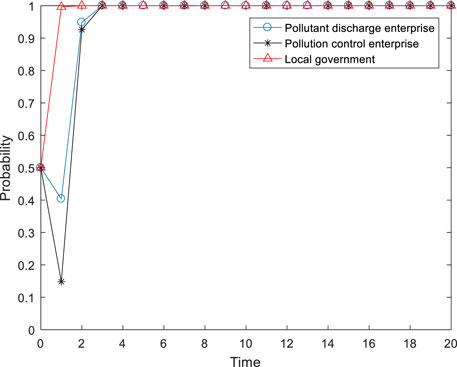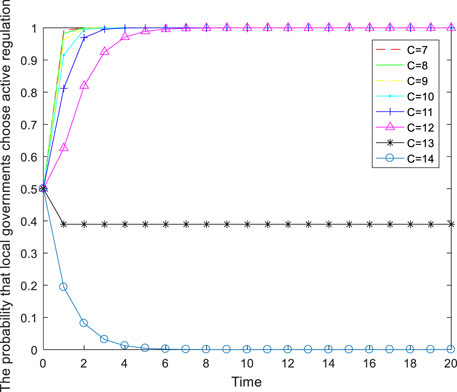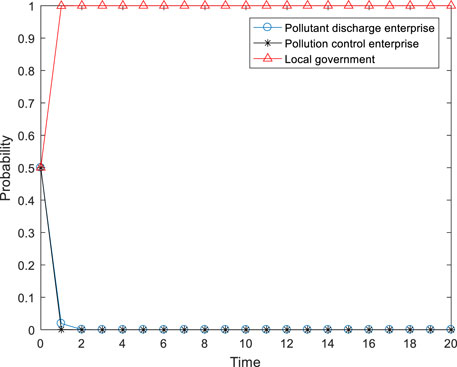- 1School of Economics and Management, Huaibei Normal University, Huaibei, China
- 2Center for Industrial and Business Organization, Dongbei University of Finance and Economics, Dalian, China
The third-party governance of environmental pollution and the pollution rights trading system are two typical examples of modern environmental governance systems. In China, the quasi-co-owned relationship of pollution rights between pollution-discharging and pollution-control enterprises is the link through which to achieve synergy between the two factors. To explore how to achieve such synergy, first, the “principle of no-fault liability” is introduced, and the responsibilities of pollution-discharging enterprises and pollution-control enterprises are defined. Second, based on the quasi-co-owned relationship of pollution rights, a revenue-sharing mechanism for pollution rights trading is designed. Finally, a tripartite evolutionary game model consisting of pollution-discharging enterprises, pollution-control enterprises and local governments is constructed, and numerical simulation is performed. The results are as follows. 1) By setting a reasonable market trading price for pollution rights, a reward and punishment distribution coefficient, an improvement in reputation gains, and a saving in pollution rights indicators become conducive to the formation of cooperative relationships between pollution-discharging and pollution-control enterprises, for which the reasonable range of the reward and punishment distribution coefficient is (0.3, 0.4]. 2) Regardless of whether a government subsidy is provided, the optimal range of the revenue-sharing coefficient from pollution rights trading is [0.5, 0.6]. 3) When a government subsidy is withdrawn, increasing the market trading price and surplus indicators of pollution rights can promote the stable operation of the third-party governance model. 4) An increase in policy support and administrative accountability of higher levels of government and a reduction in supervision costs for local governments can help these parties effectively avoid addressing the absence of local government supervision. It is recommended that third-party governance enterprises participate in pollution rights trading to implement the main responsibilities of pollution-discharging and pollution-control enterprises and to set a reasonable revenue-sharing coefficient and reward and punishment distribution coefficient of pollution rights.
1 Introduction
“Lucid waters and lush mountains are invaluable assets.” As China’s economy enters the stage of high-quality development, environmental pollution is receiving increasingly widespread attention from governments at all levels as well as from the public (Shi et al., 2022). In March 2020, the General Office of the Communist Party of China (CPC) and the General Office of the State Council issued the “Guiding Opinions on Building a Modern Environmental Governance System,” proposing that the third-party governance of environmental pollution be actively promoted, the corporate responsibility system for environmental governance be improved, and the trading of pollution rights be carried out. The third-party control of environmental pollution refers to a market-oriented pollution control model in which pollution-discharging enterprises entrust the obligation of environmental pollution control to pollution-control enterprises so that the latter can perform such tasks on behalf of the former by signing contracts with and paying fees for the third-party governance of environmental pollution. The introduction of market mechanisms has increased the scale, specialization and efficiency of pollution control (Zhou C. H. et al., 2019). The pollution rights trading system refers to the incentives for enterprises to economize pollution rights indicators in terms of technology improvements and pollution control on the premise of implementing the management of pollutant discharge permits and the total amount of pollutants discharged (Cheng et al., 2016; Zheng Y. F. et al., 2021). This indicator can be used to measure paid transfers between enterprises (Ye et al., 2020). The third-party governance of environmental pollution and the pollution rights trading system both have the introduction of market factors, the promotion of public‒private cooperation, and the optimization of resource allocation as their spiritual cores.
In the “Implementation Opinions on Promoting Third-Party Governance of Environmental Pollution” (hereinafter referred to as the Implementation Opinions) issued by China’s former Ministry of Environmental Protection (MEP) in 2017, the cooperative development of the third-party governance of environmental pollution and pollution rights trading was proposed, the participation of third-party governance units for pollution rights trading was supported, the establishment and improvement of the system for the paid use of pollution rights was encouraged, the pilot programs of pollution rights trading were actively improved, and the interests of different economic entities were regulated through the market to create profit margins for third-party governance units. The pollution reduction achieved by third-party control is credited to the pollution rights account of the pollution unit, which acts as the main body of trading and revenue from pollution rights. Third-party governance units should be supported to reasonably share the proceeds of the pollution rights trading of emission units through contractual agreements. However, at present, China’s current legislation and institutional design do not propose a reasonable path through which third-party governance units can actually participate in pollution rights trading (Ren, 2023).
The “quasi-co-owned relationship of pollution rights” refers to the formation of a quasi-co-owned relationship of pollution rights between pollution-discharging and pollution-control enterprises, and the two parties agree to reasonably share the proceeds of pollution rights trading according to a certain distribution ratio (Ren, 2023). The form of co-ownership between pollution-discharging and pollution-control enterprises is agreed upon through a contract, and based on the reality in which pollution discharge rights are shifting to paid use, the two parties can negotiate the specific conditions of co-ownership on the basis of weighing their interests, which may be either shareholding or joint communion. In share-based sharing, the two parties agree on the environmental service contract in terms of their respective shares of pollution rights; for example, the two parties agree that the third-party enterprise shall enjoy all or part of the surplus indicators generated through its governance behaviors. In joint ownership, pollution-discharging and pollution-control enterprises do not divide the shares of pollution rights; instead, they jointly enjoy rights and assume obligations. Based on the quasi-co-owned legal relationship of pollution discharge rights, third-party pollution-control enterprises can prevent failure in terms of adhering to environmental service contracts due to the arbitrary disposition of pollution discharge rights by pollution-discharging enterprises, and pollution-discharging enterprises can urge third-party enterprises to adhere to contracts by assuming the corresponding responsibilities. Therefore, the quasi-co-owned relationship of pollution rights is key for achieving synergy between the third-party governance of environmental pollution and the pollution rights trading system.
Based on the quasi-co-owned relationship of pollution rights, by clarifying the behavioral strategies of stakeholders such as pollution-discharging enterprises, pollution-control enterprises and local governments, the optimal path for third-party governance enterprises to participate in pollution rights trading can be explored, and the synergy between the third-party governance of environmental pollution and the system of pollution rights trading can be realized, which is of great theoretical significance and practical value for further promoting the effective governance of environmental pollution in China.
2 Literature review
The results related to this study involve four main aspects.
First, studies on the third-party governance mechanism of environmental pollution have been conducted. Environmental pollution risk has the characteristics of fluidity and uncertainty and being able to cross time space, which has led to institutional limitations in terms of the national and market governance mechanisms of environmental pollution, and there is an urgent need to construct a third-party governance mechanism for environmental pollution (Wu et al., 2023). With the support and promotion of the government, enterprises, citizens and social groups (Cao et al., 2021), China adopted the third-party governance model of environmental pollution in 2013. The study of the third-party governance model of environmental pollution in China involves two main aspects. First, in terms of the definition of third-party governance responsibilities for environmental pollution, some scholars have pointed out that in the current environmental liability system centered around the responsibility of polluting enterprises, pollution-discharging enterprises and third-party pollution-control enterprises are faced with unclear responsibilities (Tang et al., 2019; Wu et al., 2023; Zhou, 2023), unclear legal provisions (Ren, 2021; Ren, 2022), and the imperfect distribution of obligations (Wang, 2020) as well as other problems. Wu et al. (2022) proposed that administrative responsibility for environmental management and civil liability for environmental torts should be defined based on the transfer and burden of the actual control rights of pollution risk. Zahar (2019) suggested that the polluter pay the principle to correct market failures and the social injustices created by transferring the costs of pollution from the public to pollution-discharging enterprises while reducing the amount of pollution generated, all the while ensuring that the principle is adhering to such regulations. Li (2019) and Tang et al. (2020a) proposed defining criminal liability in the third-party management of environmental pollution based on the results of corporate environmental credit evaluation and by screening the identity of “polluters,” respectively. Moreover, Huang et al. (2023) designed a reward and punishment distribution incentive mechanism based on the “principle of sharing responsibility,” which promotes trust and cooperation between pollution-discharging and third-party governance enterprises. Second, in terms of the specific practice of the third-party governance of environmental pollution, Hu (2021) proposes that at the level of institutional improvement, the government’s responsibility for the process supervision of environmental governance projects should be clarified, and that at the level of practice promotion, the main position of state-owned enterprises in the third-party governance of environmental pollution should be further clarified. In the face of the risk of third-party governance failure, a more standardized incentive system design is needed (Lv et al., 2019), and thus, a sound and effective incentive mechanism has been established (Han et al., 2020); however, excessive incentives are not conducive to improving governmental regulatory agencies’ own performance (Wei et al., 2022), and hence, scholars have proposed formulating and dynamically and progressively implementing a third-party environmental pollution governance fiscal policy, which is conducive to improving the market mechanism of third-party pollution management (Zhou W. J. et al., 2019). In addition, the punishment mechanism is also essential. For example, Xu et al. (2019) proposed that the government use punishment as its main regulatory measure and dynamically adjust punishment for illegal behavior in a timely manner according to the degree of perfection of the third-party environmental pollution governance system.
Second, studies on the pollution rights trading system have been conducted. In 1975, the U.S. Environmental Protection Agency began to experiment with an economic incentive method, which is now known as the pollution rights trading system (Tietenberg, 1998). In essence, this system is a tool for solving environmental problems through the design of property rights. Many scholars have conducted research on the feasibility of such a pollution rights trading system. According to Coase (1960), the most effective way in which to solve the problem of environmental pollution is to provide a mechanism for clarifying environmental property rights, conducting transactions in the market and solving environmental pollution through the relationship between transaction costs and property rights arrangements. This point of view has thus been the embryonic thought of environmental property rights theory. Crocker et al. (1996) further studied the relationship between environmental pollution and property rights by combining the theory of property rights with the management of air pollution; they argued that air pollution can be effectively controlled by clarifying property rights and made preliminary suggestions for the management of air pollution from the perspective of property rights. Dales (1968) proposed the concept of “pollution rights trading” when studying the means of eliminating the property rights of water pollution issues and believed that changing the nontradable property rights system to a tradable property rights system would be more helpful in solving the pollution problem. Montgomery (1972) analyzed the difference between pollution rights and traditional pollution control means from the perspective of costs and benefits and proved that the efficiency level of the pollution rights trading system is greater than that of traditional means of pollution control. Moreover, Stavins (1995) conducted a more rigorous analysis of the pollution trading system and clarified the trading content. Hahn et al. (1989) revealed the relationship between the implementation effect of the pollutant discharge permit trading system and the initial distribution of pollutant discharge permits. Furthermore, Solomon (1999) considered the potential contribution of new institutional economics to pollution rights trading; for example, new institutional economics was used to develop theoretical insights and a series of predictions on the performance of the pollution rights trading system.
In recent years, the Chinese government and scholars have also paid great attention to and studied the pollution rights trading system. Song et al. (2015) and Tang et al. (2020b) suggested that the pollution rights trading system, as a means of environmental governance, is designed to incentivize enterprises to achieve the goal of sustained reductions in pollution emissions and to improve their production technology and total factor productivity through market-based means. Zeng et al. (2020) constructed an empirical analysis framework at the microenterprise level based on empirical data from 478 thermal power plants and found that the pollution rights trading system has a positive impact on carbon dioxide emission reductions in Chinese power plants. Using data from Guangdong Province, Cheng et al. (2016) found that the pollution rights trading system can significantly reduce nitrogen dioxide and nitrogen oxide emissions in Guangdong Province. Luo et al. (2022) used the data of Chinese A-share listed companies in the Shanghai and Shenzhen stock exchanges during the period 2003–2014; they used the pilot policy of pollution rights trading in 2007 as a natural experiment and discussed the effect of this pilot policy on the promotion of the green technology innovation of enterprises. The empirical research has shown that pollution rights trading policy can significantly promote the green technology innovation of enterprises in pilot areas. Yao et al. (2022) used the quasinatural experiment of the difference method to assess the impact of the pollution rights trading system on SO2 emissions in China based on the panel data of 285 cities in China from 2004 to 2018 and found that the pollution rights trading system has a significant effect on SO2 emissions. Furthermore, Zhang et al. (2020) used the difference-in-differences method to assess the impact of the pollution rights trading system on carbon emission reductions and found that this effect is particularly prominent in the economically developed eastern region.
Third, studies on the rationality of the participation of third-party environmental pollution-control enterprises in pollution rights trading have been conducted. The third-party control of environmental pollution means that pollution-discharging enterprises pay fees in accordance with contracts and that professional environmental service companies carry out pollution control (Tang, 2021), using market means to take social capital as the main source of pollution control investment. In theory, the third-party governance of environmental pollution and pollution rights trading system both follow the operational logic of introducing market factors, promoting public‒private cooperation, and achieving the optimal allocation of resources. In reality, the institutional designs of the third-party governance of environmental pollution and rights trading are both compatible and different (Ren, 2023). For pollution-discharging enterprises, in third-party governance, cooperation with pollution-control enterprises can help them transfer their obligation toward pollution control, but the benefits obtained by pollution-control enterprises are essentially the operational and environmental benefits obtained by pollution-discharging enterprises through their business activities; moreover, there is a zero-sum game relationship between pollution-discharging and pollution-control enterprises. The Implementation Opinions propose a reasonable agreement between pollution-discharging and pollution-control enterprises to share pollution emission rights trading proceeds through enhancing the effectiveness of environmental pollution control and economizing the pollution rights indicators. This agreement can provide both sides with the opportunity to obtain a larger number of benefits by virtue of pollution rights trading, breaking the single fixed mode of cooperation and then moving from the zero-sum game to a cooperative game. Therefore, it is reasonable for third-party governance enterprises to participate in pollution rights trading (Ren, 2023).
Fourth, in the application of methodology, as an important theoretical tool of information economics, evolutionary game theory breaks through the assumption of complete rationality in traditional game theory and can be more reasonably used to describe various game interactions in the real world on the premise of bounded rationality. In the process of strategy selection, the result of equilibrium is to reach the equilibrium state through continuous trial and error, adjustment and improvement. Many scholars have applied the advantages of bounded rationality and an evolutionarily stable strategy in the study of third-party governance models of environmental pollution. For example, Peng et al. (2020) constructed a tripartite evolutionary game model consisting of local governments, polluters and environmental service providers in the process of environmental governance to capture the interaction mechanism among the three. Liu et al. (2023) constructed an evolutionary game model consisting of four parties—small and medium-sized livestock farmers, third-party enterprises, consumers, and local governments—and concluded that the main factors affecting third-party recycling and treatment include government regulation and market demand for environmental protection and organic fertilizers. Sun et al. (2023) constructed a tripartite groundwater ammonia nitrogen pollution control evolution game model for wastewater-discharging enterprises, third-party treatment enterprises and local governments, and the results of the study showed that setting a reasonable reward and punishment allocation coefficient is the basis for advancing the proactive pollution control of wastewater-discharging enterprises and third-party treatment enterprises and that the changing revenue from pollution rights trading is the key factor influencing the strategic choices of the three parties. Zhou W. J. et al. (2019) constructed a tripartite evolutionary game model of local governments, polluting enterprises and third-party enterprises and concluded that strengthening relevant fiscal policies, reducing the risks of polluting enterprises and third-party enterprises, and improving the benefits to local governments are conducive to promoting third-party environmental pollution governance in China. Zheng J. J. et al. (2021) constructed stochastic differential cooperation Stackelberg and cooperative game models for environmental pollution control between pollution-discharging enterprises and third-party control enterprises under the external supervision and incentives of the local government, providing a decision-making basis for the construction of a third-party governance mechanism for environmental pollution. Huang et al. (2023) constructed a signaling game model between the government and governance enterprises based on prospect theory and studied how the government adopts effective supervision strategies to differentiate and regulate third-party governance enterprises with different technology levels in the market. Furthermore, Zou et al. (2023) used the third-party governance of environmental pollution under the incentive and constraint mechanism as the research object and constructed a game model involving pollution-discharging enterprises, third-party environmental service providers and local governments; they found that there a moral hazard is present in pollution-discharging enterprises and third-party governance enterprises and that the incentive and constraint mechanism can avoid the occurrence of this moral hazard to a certain extent.
The abovementioned literature has the following limitations. 1) At present, some scholars have paid attention to the importance of promoting the synergy between the third-party treatment of environmental pollution and the pollution rights trading system but have focused mainly on the institutional basis and practical reasons for the participation of third-party pollution-control enterprises in pollution rights trading (Ren, 2023); moreover, no scholars have been able to explicitly propose specific ways in which to realize the synergy between the two. 2) Current studies on the third-party governance of environmental pollution (Zhou C. H. et al., 2019; Wu et al., 2023) and pollution rights trading systems (Zeng et al., 2020; Yao et al., 2022) are abundant, but in terms of the path of third-party pollution-control enterprises in participating in pollution rights trading, there are only a relatively small number of qualitative jurisprudential studies (Ren, 2023), and no scholars have yet quantitatively studied the reasonable path through which third-party pollution-control enterprises actually participate in pollution rights trading. 3) In terms of the definitions of responsibility for pollution-discharging enterprises and third-party pollution-control enterprises, existing scholars have noted that how to divide responsibilities (Tang et al., 2019; Zhou, 2023) and how to define these responsibilities remain unclear (Wu et al., 2023); additionally, scholars have proposed solutions such as the “polluter pays principle” (Zahar, 2019) and the “principle of sharing responsibility” (Huang et al., 2023), but these means have not completely solved the problem of defining third-party governance responsibilities for environmental pollution. 4) In terms of the study of the operation of the third-party governance model, existing studies have considered the importance and significance of government subsidies (Huang et al., 2023), fiscal policies (Zhou W. J. et al., 2019), etc., but no scholars have studied how to maintain stable cooperation between pollution-discharging enterprises and third-party pollution-control enterprises when government subsidies are withdrawn.
In summary, the theoretical contributions of this study are as follows: 1) In this study, the “principle of no-fault liability” is introduced, the environmental pollution control responsibilities of pollution-discharging enterprises and pollution-control enterprises are clearly defined, and then a reward and punishment distribution mechanism between pollution-discharging enterprises and pollution-control enterprises is designed. Both parties share rewards and bear penalties in a certain proportion to guide and strengthen the cooperative relationship between them. 2) Based on the “quasi-co-owned relationship of pollution rights,” this study designs a revenue-sharing mechanism for pollution rights trading between pollution-discharging enterprises and pollution-control enterprises. In other words, pollution-discharging enterprises and pollution-control enterprises can agree in advance on a revenue-sharing scheme of pollution rights acceptable to both parties in the environmental pollution treatment agreement, and both parties share the revenue of pollution rights trading in a certain proportion. Thus, the interests of both parties are further linked to form a relationship of mutual supervision and ultimately realize the synergy between the third-party governance of environmental pollution and the pollution rights trading system and promote the effective management of environmental pollution. 3) In this study, evolutionary game theory is introduced to the collaborative study of the third-party governance of environmental pollution and the pollution rights trading system, and a tripartite evolutionary game model consisting of pollution-discharging enterprises, pollution-control enterprises and local governments is constructed to explore the behavioral choices and interaction relationships of the three entities in the process of environmental pollution governance. This study provides a reference for further improving the third-party governance model of environmental pollution.
3 Model construction and analysis
3.1 Path analysis
The participation of third-party pollution-control enterprises in pollution rights trading can realize the connection between the third-party control of environmental pollution and the pollution rights trading system (Ren, 2023). To achieve synergy between the third-party control of environmental pollution and the pollution rights trading system, the participation of third-party pollution-control enterprises in pollution rights trading must act as the bridge. First, clarifying the distribution of rights and responsibilities between pollution-discharging and pollution-control enterprises is the primary prerequisite for supporting the participation of third-party pollution-control enterprises in pollution rights trading. Therefore, the “principle of no-fault liability” is introduced in the process of government supervision to clearly define the pollution control responsibility of pollution-discharging and third-party pollution-control enterprises. Second, based on the “principle of no-fault liability,” a reward and punishment distribution mechanism is designed to connect the interests of pollution-discharging enterprises with those of pollution-control enterprises to form a mutually supervised relationship (Huang et al., 2023). Finally, based on the quasireal attribute of pollution rights (Cheng et al., 2016), pollution-discharging and third-party pollution-control enterprises form a quasi-co-owned relationship of pollution discharge rights according to legal relationships environmental treatment agreements. A revenue-sharing mechanism for pollution discharge trading is designed according to the specific performance of both parties in the pollution control process and the transfer income of surplus pollution rights indicators. By setting a reasonable profit sharing coefficient for pollution rights trading, we can encourage third-party pollution-control enterprises to participate in pollution rights trading and ultimately realize the institutional coordination of third-party environmental pollution control and pollution rights trading.
3.2 Method introduction
As an important theoretical tool of information economics, evolutionary game theory breaks through the assumption of complete rationality in traditional game theory and can be more reasonably used to describe various game interactions in the real world on the premise of bounded rationality. In the decision-making process, the participants in the game will not fully consider all possible strategies and outcomes but will follow the principles of feasibility and satisfaction. Each participant will comprehensively consider multiple factors and continuously learn and adjust their decision-making behavior in a timely manner according to changes in the external environment, ultimately achieving a stable state and achieving long-term equilibrium.
A three-way game is a game involving three independent decision makers, each of which has its own set of strategies and corresponding payoffs. The construction and analysis process of the tripartite evolutionary game model is as follows: Firstly, it is necessary to clarify the strategic space of each decision maker, that is, to determine all possible strategies that pollution-discharging enterprises, pollution-control enterprises and local governments can choose. Secondly, the interactions among pollution-discharging enterprises, pollution-control enterprises and local governments are clarified. On this basis, parameter assumptions are made, and then the income payment matrix is constructed to describe the income of each decision maker under different strategy combinations. Thirdly, based on the income payment matrix, the expected gains and average expected gains of pollution-discharging enterprises, pollution-control enterprises and local governments when choosing corresponding strategies are calculated, and the dynamic equation of tripartite replication is established. Finally, the replication dynamic equation is solved, and the stability of the equilibrium point of the tripartite evolutionary game system is evaluated.
3.3 Model assumptions
Hypothesis 1:. The game subjects in this study are pollution-discharging enterprises, pollution-control enterprises and local governments, all of which are bounded-rational subjects under the influence of unavoidable factors such as insufficient information, asymmetry, and limited individual knowledge. The three game subjects achieve dynamic equilibrium through continuous learning, adaptation, and imitation, and the strategy selection gradually becomes optimal over time.
Hypothesis 2:. The strategies that pollution-discharging enterprises can adopt include those of “complying with cooperation” and “violating cooperation.” “Complying with cooperation” refers to the signing of environmental service contracts between pollution-discharging and pollution-control enterprises and the payment of treatment fees to pollution-control enterprises based on the actual pollution control situation. The production revenue of the pollution-discharging enterprise is set to
Hypothesis 3:. The strategies that pollution-control enterprises can adopt include “active pollution control” and “passive pollution control.” When pollution-control enterprises actively control pollution, they adopt means such as increasing investment in environmental control technologies. At this time, the unit control cost of the pollution-control enterprises is
Hypothesis 4:. The strategies that local governments can adopt include “active supervision” and “passive supervision.” When the local government actively supervises, if pollution-discharging enterprises choose to abide by cooperation, then the local government rewards them with a certain reward,
Hypothesis 5:. When pollution-discharging and pollution-control enterprises both earnestly perform environmental service contracts and actively control pollution, regardless of whether the local government chooses active or passive supervision, they obtain corresponding social benefits due to the improvement of the ecological environment
Hypothesis 6:. Regarding the attribution of environmental pollution control responsibility, the “principle of no-fault liability” is used to define responsibility. Table 1 shows the specific situation classification and responsibility definition. When the pollution-discharging enterprise is at fault but the pollution-control enterprise is not at fault, the pollution-discharging enterprise bears the full penalty, and the pollution-control enterprises receives the full reward. When the pollution-control enterprise is at fault but the pollution-discharging enterprise is not at fault, the pollution-control enterprise bears the full penalty, and the pollution-discharging enterprise receives the full reward. In addition, the pollution-discharging enterprise can claim compensation from the pollution-control enterprise according to the environmental service contract, which is recorded as

Table 1. Division and definition of ecological and environmental pollution tort liability in the third-party governance model of environmental pollution.
Hypothesis 7:. In the game process among pollution-discharging enterprises, pollution-control enterprises and local governments, the probability that pollution-discharging enterprises adopt the strategy of “complying with cooperation” is
Based on the above assumptions, the benefits for pollution-discharging enterprises, pollution-control enterprises and local governments under different behavioral strategies can be obtained, as shown in Table 2.
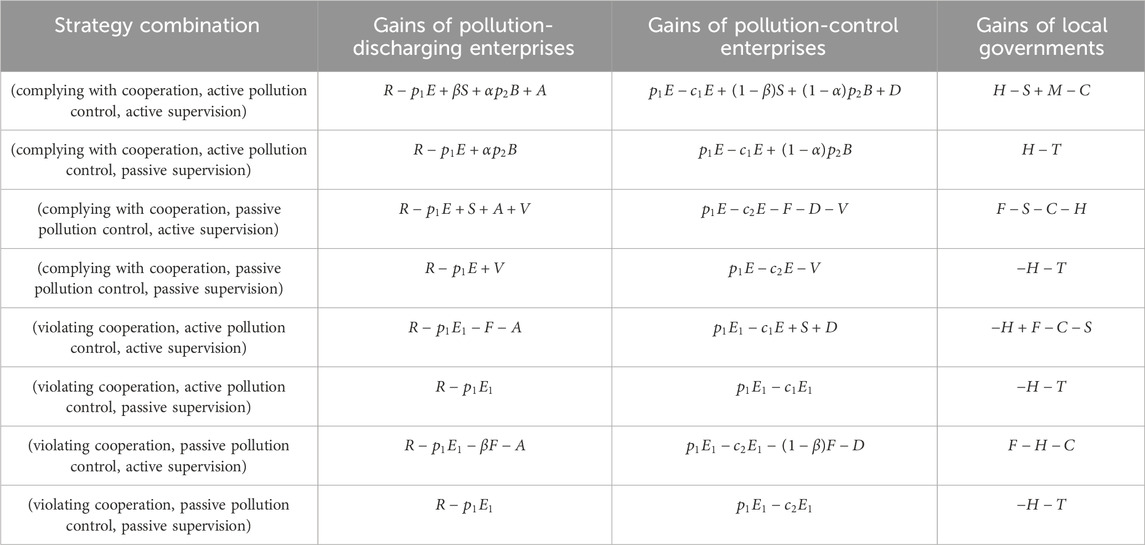
Table 2. Behavioral strategy combinations and benefits for pollution-discharging enterprises, pollution-control enterprises and local governments.
3.4 Model construction
The pollution-discharging enterprise’s expected gain when it chooses the “complying with cooperation” strategy is shown in Eq. (1):
The pollution-discharging enterprise’s expected gain when it chooses the “violating cooperation” strategy is shown in Eq. (2):
The pollution-discharging enterprise’s average expected gain is shown in Eq. (3):
The replicator dynamics equation of the constructed pollution-discharging enterprise is as follows:
The pollution-control enterprise’s expected gain when it chooses the “active pollution control” strategy is shown in Eq. (5):
The pollution-control enterprise’s expected gain when it chooses the “passive pollution control” strategy is shown in Eq. (6):
The pollution-control enterprise’s average expected gain is shown in Eq. (7):
The replicator dynamics equation of the constructed pollution-control enterprise is as follows:
The local government’s expected gain when it chooses the “active supervision” strategy is shown in Eq. (9):
The local government’s expected gain when it chooses the “passive supervision” strategy is shown in Eq. (10):
The local government’s average expected gain is shown in Eq. (11):
The replicator dynamics equation for the local government is constructed as follows:
By combining Eqs 4, 8, 12, the three-dimensional replication dynamic system of pollution-discharging enterprises, pollution-control enterprises and local governments can be obtained as shown in Eq. (13):
3.5 Model analysis
3.5.1 Pollution-discharging enterprise strategic stability analysis
We take the first partial derivative of
We order
Proposition 1:. When
Proof: From the stability determination theorem of the differential equation, when both
Proposition 1 shows that the behavioral choices of pollution-discharging enterprises are influenced by the behavioral strategy of local governments. When the probability of local governments’ active supervision is low, pollution-discharging enterprises tend to choose the strategy of “violating cooperation.” When the probability of local governments’ active supervision is higher than a certain level, pollution-discharging enterprises tend to choose the strategy of “complying with cooperation.” Intensified supervision by local governments is conducive to encouraging pollution-discharging enterprises to adhere to their environmental service contracts with third-party control enterprises and actively participate in environmental pollution control.
3.5.2 Pollution-control enterprises’ strategic stability analysis
We take the first partial derivative of
We order
Proposition 2:. When
Proof: Because
Proposition 2 shows that the behavioral strategies of third-party pollution-control enterprises are influenced by the behavioral strategies of local governments. When the degree of probability of active supervision by the local government is less than a certain level, pollution-control enterprises tend to choose the passive pollution control strategy. When the degree of probability of active supervision by the local government is high, pollution-control enterprises tend to choose the active pollution control strategy. Therefore, the active performance of local governments’ regulatory function is conducive to promoting stable and mutual trust cooperative relationships between pollution-discharging and pollution-control enterprises in the third-party governance model of environmental pollution.
3.5.3 Analysis of local government strategic stability
We take the first partial derivative of
We order
Proposition 3:. When
Proof: We take the first partial derivative of
Proposition 3 shows that the choice of behavioral strategy of the local government is influenced by the behavioral strategy of pollution-discharging enterprises. When the probability of pollution-discharging enterprises voluntarily abiding by cooperation is lower than a certain level, the local government tends to choose the “active supervision” strategy. When the probability of pollution-discharging enterprises voluntarily abiding by cooperation is high, the local government relaxes its supervision and is inclined to choose the “passive supervision” strategy. Therefore, the voluntary performance of environmental service contracts by pollution-discharging enterprises and enhanced awareness of law-abiding cooperation are conducive to the effective and rational allocation of government administrative resources.
3.5.4 Stability analysis of the equilibrium point of the tripartite evolutionary game system
We order
According to the Lyapunov stability determination rule, when all the eigenvalues of the Jacobian matrix are negative real numbers, that is, when
As shown in Table 3, there are four possible stable situations in the game system composed of pollution-discharging enterprises, pollution-control enterprises and local governments:
1) When
2) When
3) When
4) When
A comparison of the above four situations reveals that the behavioral strategy choices of pollution-discharging enterprises, pollution-control enterprises and local governments are related to the differences between the gains and expenditures. When pollution-discharging enterprises consciously abide by the environmental service contract signed by pollution-control enterprises and the sum of the benefits such as pollution rights trading income, government rewards and good enterprise reputation obtained by actively participating in environmental pollution control is greater than the benefits obtained by pollution-discharging enterprises violating cooperation and stealing discharge, pollution-discharging enterprises eventually choose the “complying with cooperation” strategy. When pollution-control enterprises actively control pollution, the sum of the gains from pollution rights trading, government subsidies, and reputation are greater than the control costs, and pollution-control enterprises eventually choose the “active pollution control” strategy. When the policy support and administrative accountability of local governments at higher levels of government are greater than the sum of local governments’ supervisory costs and subsidy expenditures, local governments ultimately choose the “active supervision” strategy.
4 Simulation analysis
The above analysis of the stable situation reveals that the equilibrium situation at each stable point may be established when certain conditions are met. However, considering practical significance and practical needs, this study further conducts numerical simulation analysis on the optimal equilibrium state
As shown in Figure 1, when the initial degree of willingness of pollution-discharging enterprise, pollution-control enterprise and local government to participate is 0.5, it is found through numerical simulation that the system ultimately evolves to the ideal stable state of
4.1 Surplus pollution rights indicators
Active cooperation between pollution-discharging enterprises and pollution-control enterprises in environmental pollution control is helpful for improving the effect of pollution control and increasing the surplus of pollution rights indicators. According to the quasi-co-owned relationship of pollution rights, due to the increase in the number of the indicators of surplus pollution rights, the total gains for both parties also increase. Therefore, as rational economic persons, pollution-discharging enterprises and pollution-control enterprises comprehensively consider their respective benefits, costs and other factors and ultimately make their own strategic choices. Keeping the other parameters unchanged, the numerical regulation of the saved pollution rights indicators
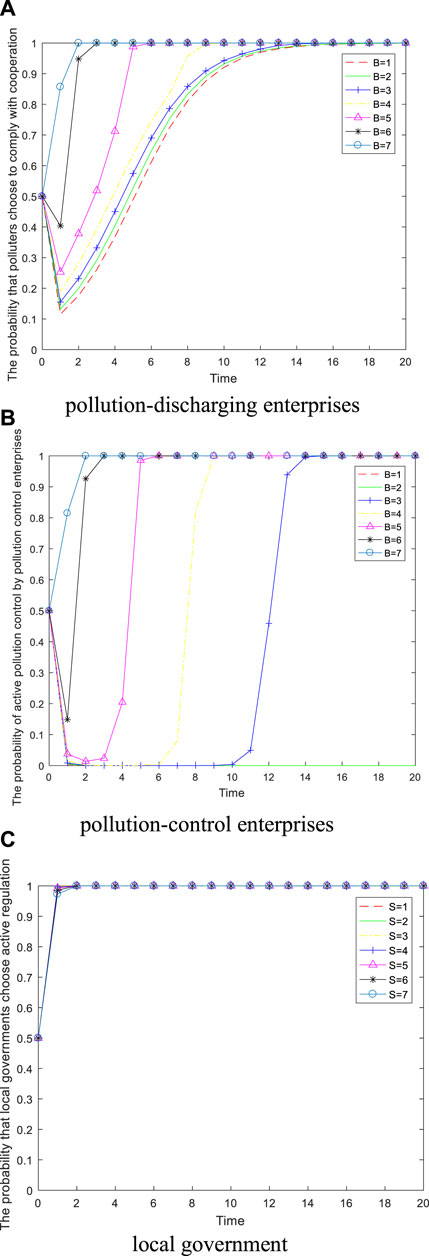
Figure 2. Impact of changes in
As shown in Figure 2A, as
As shown in Figure 2B, when
Combined with Figures 2A, B, it can be seen that when
When the surplus pollution rights indicators increase to a certain extent, for example, when
As shown in Figure 2C, for local governments, even though pollution-discharging enterprises and pollution-control enterprises actively cooperate to control environmental pollution, with the increase in the number of surplus pollution rights indicators, the enthusiasm of local governments for supervision has always been very high. The reason for this is that the fundamental goal of local governments is to effectively control environmental pollution and maximize the overall welfare of society, and thus, effective supervision is essential.
In summary, an increase in the number of surplus pollution discharge rights indicators can increase the total income of both pollution-discharging enterprises and pollution-control enterprises. Regarding limited rational economic personnel, the main purpose of pollution-discharging enterprises and pollution-control enterprises is to increase profits. Therefore, the increase in the surplus pollution discharge rights indicators not only increases the total profits of both parties but also improves the strategic choices of pollution-discharging enterprises and pollution-control enterprises, which is conducive to promoting a positive cooperative relationship between pollution-discharging enterprises and pollution-control enterprises and promoting the evolution of the system to the ideal state. In addition, an increase in surplus pollution discharge rights indicators has a greater impact on the behavioral choices of pollution-control enterprises.
4.2 Trading price of pollution rights per unit in the market
The market trading price of pollution rights trading is another important factor that affects the benefits brought about by pollution rights trading. Due to the increase in the trading price of pollution rights trading per unit in the market, the total benefits obtained by pollution-discharging enterprises and pollution-control enterprises as a result increases, which may affect the behavioral strategy selection of both parties. Keeping the other parameters unchanged, the numerical regulation of the market trading price of pollution rights trading per unit is
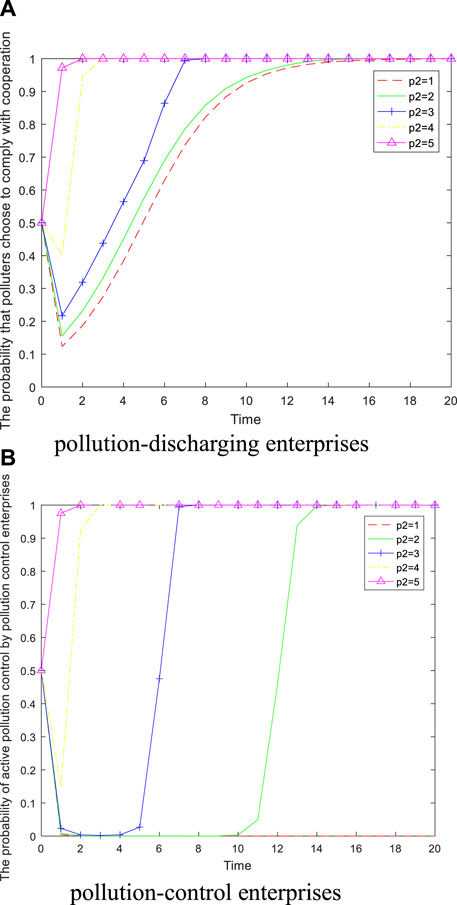
Figure 3. Impact of changes in
As shown in Figure 3A, as the trading price of each unit of pollution rights in the market increases, the strategic choice of pollution-discharging enterprises is always “complying with cooperation,” but the convergence rate changes. Specifically, when
As shown in Figure 3B, when
Combined with Figures 3A, B, it can be seen that when
With the gradual increase in the market trading price of pollution rights trading per unit, for example, when
In summary, an increase in the trading price of each unit of pollution rights in the market can simultaneously increase the total income of pollution-discharging enterprises and pollution-control enterprises, improve the strategic choice of pollution-discharging enterprises and pollution-control enterprises, and thus help strengthen the cooperative relationship between pollution-discharging enterprises and pollution-control enterprises in environmental pollution control and promote the evolution of the system to an ideal state. In addition, an increase in the trading price of each unit of pollution rights in the market has a greater impact on the behavioral choices of pollution-control enterprises.
4.3 Revenue-sharing coefficient of pollution rights trading
The Implementation Opinions clearly point out that the participation of third-party governance units in the trading of pollution rights is supported, and the interests of different economic subjects are adjusted through the market to create profit margins for third-party governance units. However, in China’s current legislation and institutional design, there is no reasonable path through which to support the actual participation of third-party governance units in the trading of pollution rights. In view of this, on the premise of the quasi-co-owned relationship of pollution rights, this study proposes that pollution-discharging enterprises and third-party pollution-control enterprises can reasonably share the pollution rights trading proceeds of emission units through the agreement of environmental service contracts and explores how the value of the sharing coefficient of pollution rights trading proceeds should be set. To study the influence of the sharing coefficient of pollution rights trading proceeds on the evolution of the system, keeping the other parameters unchanged, only the sharing coefficient
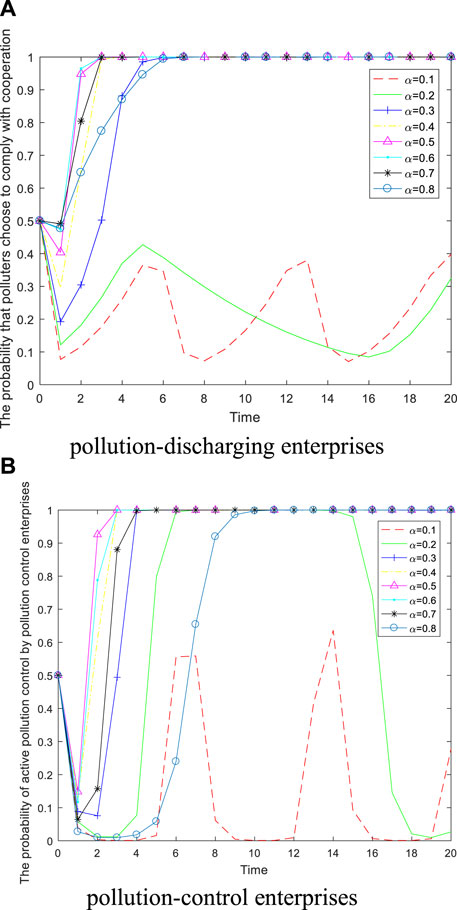
Figure 4. Impact of changes in
As shown in Figures 4A, B, when
When
However, when
In summary, the assumption that pollution-discharging enterprises and third-party pollution-control enterprises reasonably share the proceeds of pollution discharge units’ pollution rights trading through environmental service contracts is tenable. When the revenue-sharing coefficient of pollution rights trading
4.4 Special subsidies for environmental pollution control established by local governments
Subsidies are a common incentive method used by the government to regulate and control the behavior of enterprises and play a certain role in incentivizing pollution-discharging and pollution-control enterprises. As rational economic personnel, pollution-discharging and pollution-control enterprises comprehensively consider special subsidies for environmental pollution control, pollution control costs and other factors to ultimately make their own strategic choices, keep the other parameters unchanged, and conduct numerical control on special subsidies
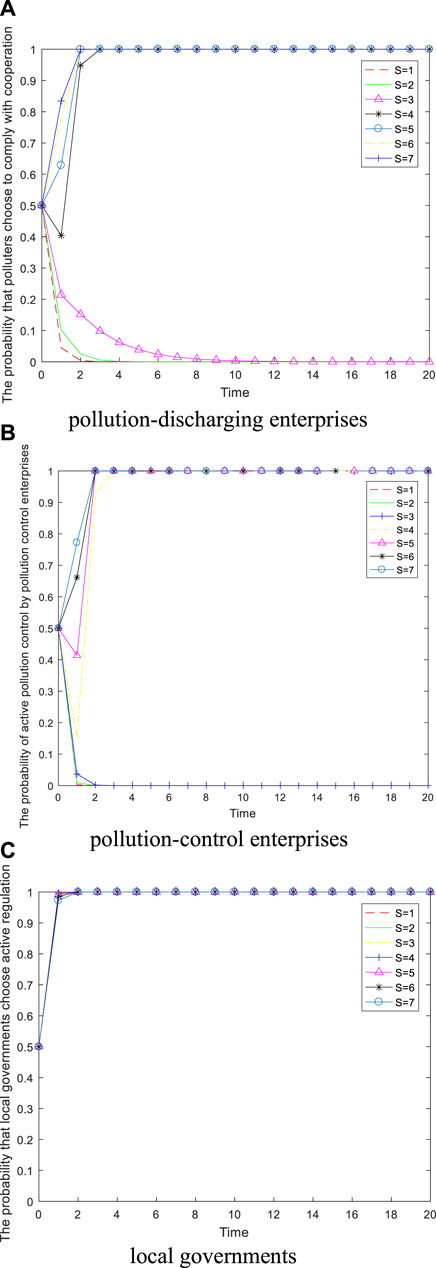
Figure 5. Impact of changes in
As shown in Figure 5A, when
As shown in Figure 5B, when
As shown in Figure 5C, for local governments, an increase in subsidies does not change their behavioral strategy choices, and local governments always choose the “active supervision” strategy. The ultimate goal of local governments is to achieve effective and proper control of environmental pollution and to maximize the overall welfare of society rather than to make a profit. Therefore, local governments adopt the incentive policy of subsidies; with an increase in
In summary, local government subsidies can effectively improve the behavior of pollution-discharging and pollution-control enterprises, helping the system achieve an ideal state.
4.5 Amount of penalty by local governments
The constraint mechanism is also a common means through which the government can regulate the behavior of enterprises. Forced by government punishment, pollution-discharging and pollution-control enterprises may change their behavioral strategy. The other parameters are kept unchanged, and local governments’ punishment amount
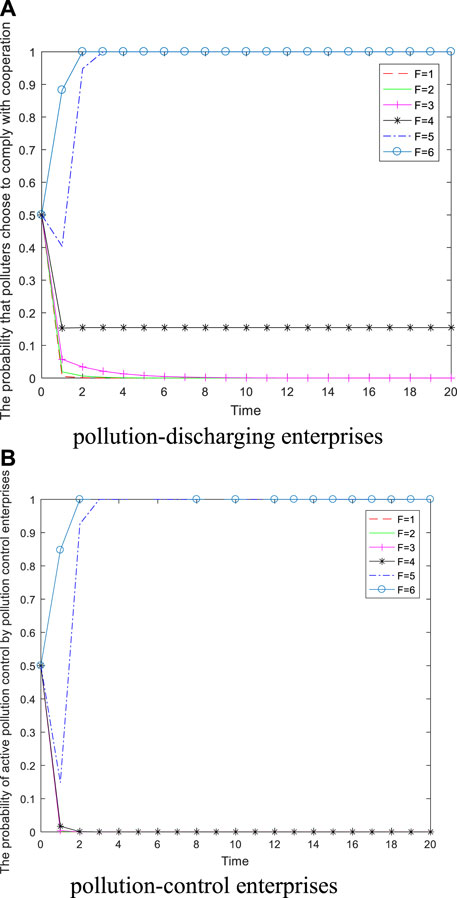
Figure 6. Impact of changes in
As shown in Figure 6A, when
As shown in Figure 6B, when
In summary, the penalties of local governments can effectively improve the strategic choices of pollution-discharging and pollution-control enterprises.
4.6 Reward and punishment distribution coefficient
On the basis of defining the responsibilities of pollution-discharging and pollution-control enterprises, a reasonable reward and punishment distribution mechanism is determined according to the actual behavior of the two parties to promote stable cooperation between them for the more effective control of environmental pollution. To study the influence of the reward and punishment distribution coefficient on system evolution, the reward and punishment distribution coefficient
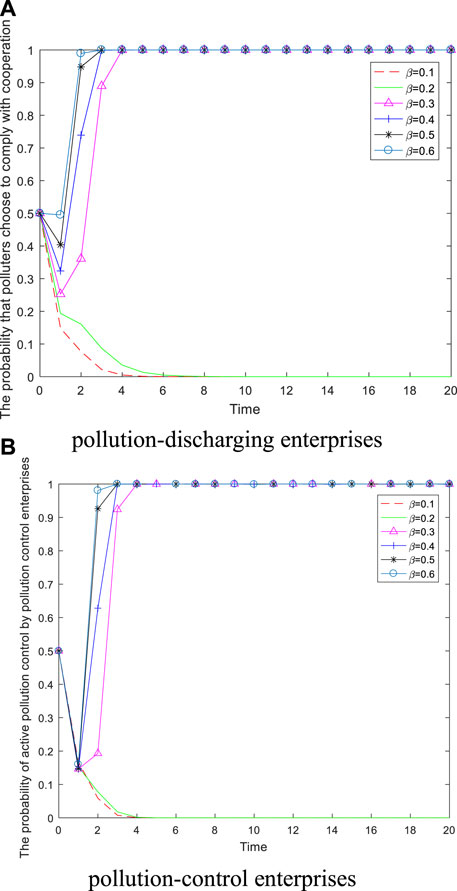
Figure 7. Impact of changes in
As shown in Figures 7A, B, when
When
With reference to Figures 7A, B, the critical value of the reward and punishment distribution coefficient is
4.7 Reputation gains of pollution-discharging enterprises
To study the effect of reputation gains on the behavior of pollution-discharging and pollution-control enterprises, while keeping other parameters constant, their respective reputation gains are controlled to observe the behavioral changes of both parties. The results are shown in Figure 8, respectively.
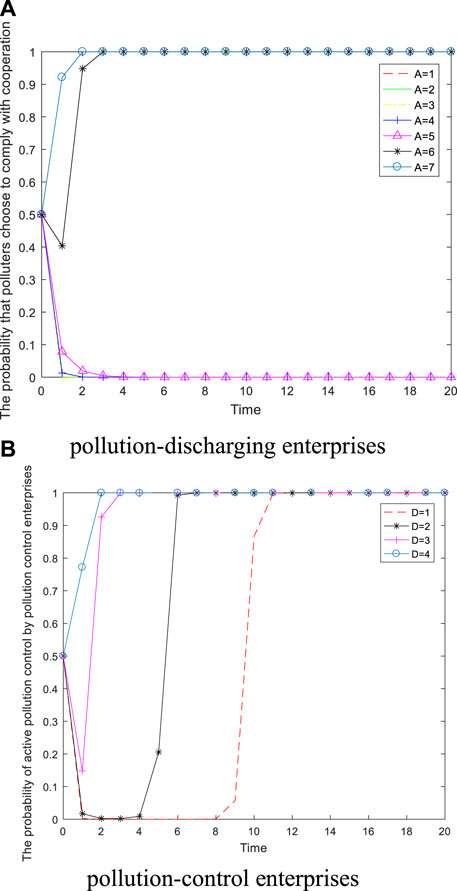
Figure 8. Impact of changes in
As shown in Figure 8A, when
4.8 Regulatory costs for local governments
As the main regulator of environmental pollution control, the government’s main purpose is to promote cooperation among pollution-discharging and pollution-control enterprises and actively carry out pollution control, but certain supervision costs are incurred in the supervision process. While keeping the other parameters constant, only the size
As shown in Figure 9, when
Excessive government subsidies easily lead to price distortion and market deformity. When a market develops to a certain stage, it is imperative to reduce the subsidy or even withdraw it altogether. Therefore, as presented below, after the withdrawal of government subsidies, changes in the third-party governance market for environmental pollution emerge. Keeping the other parameters constant, let the government subsidy
As shown in Figure 10, when a government subsidy is withdrawn, the third-party governance model of environmental pollution cannot be maintained, and the system degenerates to the undesirable state of
4.9 Adjustment of the price per unit of pollution rights trading in the market after the withdrawal of government subsidies
After the withdrawal of government subsidies, pollution-discharging and pollution-control enterprises have one less source of income. Therefore, the trading price of each unit of pollution rights in the market is directly related to the total income of both parties. On the basis of
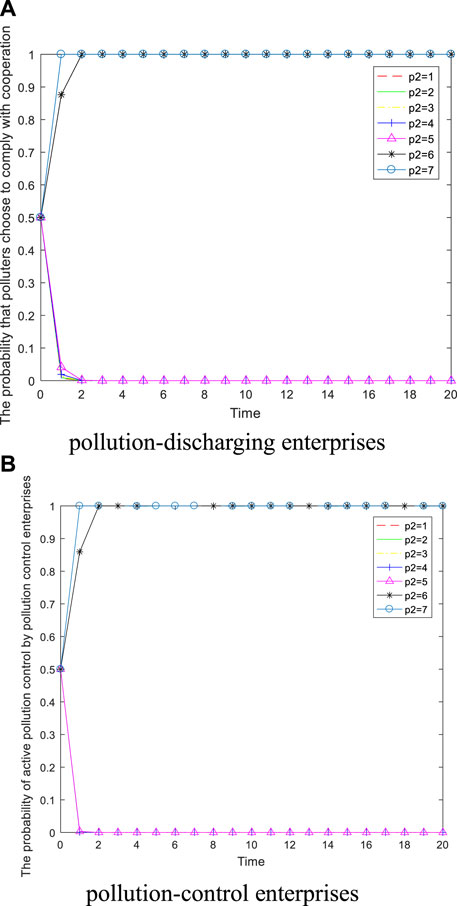
Figure 11. Impact of changes in
With reference to Figure 11, it can be seen that when
4.10 After the withdrawal of government subsidies, the remaining pollution rights indicators are adjusted
The amount of surplus pollution rights is also directly related to the total revenue of pollution-discharging and pollution-control enterprises. On the basis of
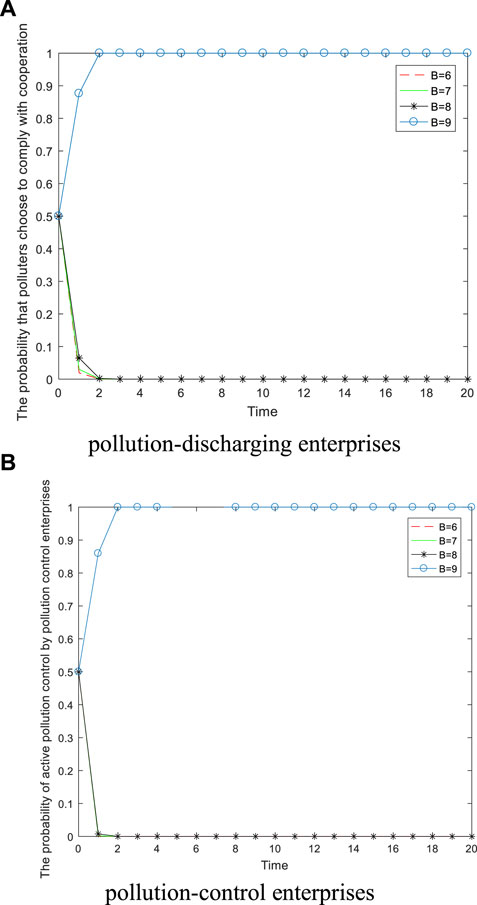
Figure 12. Impact of changes in
With reference to Figure 12, it can be seen that when
5 Conclusion and policy suggestions
This study takes the realization of the connection between the third-party governance of environmental pollution and the pollution rights trading system as the breakthrough point; clearly defines the responsibilities of pollution-discharging and pollution-control enterprises; explores the innovative form of the quasi-co-owned relationship of pollution rights in third-party governance; constructs a tripartite evolutionary game model composed of pollution-discharging enterprises, pollution-control enterprises and local governments; analyses the stability of the strategies of the three parties; solves eight equilibrium points and analyses their stability conditions according to the Lyapunov stability determination theorem; and simulates the influence of the relevant parameters on the subject’s strategy selection via MATLAB. The main research conclusions are presented below.
(1) The behavioral strategies of pollution-discharging enterprises, pollution-control enterprises and local governments are comprehensively affected by a variety of factors, and the decisions of the three actors affect each other. The keys to making the system evolve toward the ideal state are to narrow the gap between the gains from illegal and unauthorized discharges by pollution-discharging enterprises, the gains from hiding the level of effort by pollution-control enterprises, and other comprehensive opportunity gains.
(2) The proceed-sharing mechanism of pollution rights trading, agreed upon based on the quasi-co-owned relationship of pollution rights, can effectively promote the establishment of a stable cooperative relationship between the two enterprise parties. The system can be made to evolve to the desired equilibrium point when the pollution rights trading price per unit in the market reaches 4 or when the pollution rights indicator of savings reaches 6. Notably, there exists a suitable interval for the coefficient of benefit-sharing of pollution rights trading, and when it is set in the range of [0.5, 0.6], the mechanism of benefit-sharing of pollution rights can have the greatest effect and utility, and the synergy between the third-party governance of environmental pollution and the pollution rights trading system can be realized.
(3) In the reward and punishment distribution mechanism designed based on the principle of no-fault liability, both pollution-discharging enterprises and pollution-control enterprises show stronger revenue sensitivity, and neither insufficient incentives nor a low reward and punishment distribution coefficient promote stable cooperation among the two. The study shows that the appropriate range of the reward and punishment distribution coefficient is (0.3, 0.4]. In addition, the potential reputation gains of pollution-discharging and pollution-control enterprises have a positive effect on their choices of behavioral strategies.
(4) When governments’ subsidy is withdrawn, under the original pollution rights trading price and pollution rights indicator, cooperation between the two sides—pollution-discharging enterprises and pollution-control enterprises—cannot continue to be maintained; at this time, by increasing the total emission trading revenue, the negative impact of the subsidy withdrawal can be offset. When the pollution rights trading price of the market reaches 6 or savings in the pollution indicator reaches 9, the ideal equilibrium can be reached, and the optimal interval of the sharing coefficient of pollution rights trading gain is still [0.5, 0.6].
(5) The active performance of regulatory functions by local governments can promote the formation of long-term and stable cooperative relationships between pollution-discharging and pollution-control enterprises. The intensity of policy support, administrative accountability and regulatory costs of the higher-level government have an important impact on the behavior of local governments.
Based on the above conclusions, the following policy suggestions are proposed.
(1) The entities involved in pollution emission rights trading should be expanded to include third-party pollution-control enterprises. Through the signing of environmental service contracts, pollution-discharging enterprises and pollution-control enterprises have formed quasi-co-owned relationships regarding emission rights, with the specific content of this relationship being determined by negotiation between the two sides; additionally, these contracts have supported third-party pollution-control enterprises in participating directly in pollution rights trading to promote the long-term development of the environmental service industry with a stable profit margin. Pollution-discharging enterprises and pollution-control enterprises share income from pollution rights trading in a certain distribution ratio so that the total income of both parties is improved, the interests of both parties are further connected, and a mutual supervision relationship is formed, which is conducive to reducing the probability of moral hazard occurrence for both parties. Through the trading of pollution rights, the total income of pollution-discharging enterprises and pollution-control enterprises can increase to encourage both sides to form a stable cooperative relationship of environmental pollution control and ultimately promote the effective control of environmental pollution.
(2) After the revenue-sharing mechanism of pollution rights is agreed upon, the revenue-sharing coefficient of pollution rights should be set in the range of [0.5, 0.6]. However, when the market situation changes, such as when the pollution control cost of pollution-control enterprises, the market trading price of pollution rights trading per unit, and the production income of pollution-discharging enterprises change, pollution-discharge enterprises and pollution-control enterprises can dynamically adjust their environmental pollution control agreements according to the actual situation and agree on the revenue sharing coefficient of pollution rights trading so that both parties can obtain satisfactory results, thereby promoting the connection and coordination of third-party governance and pollution rights trading systems and jointly achieving long-term sustainable development.
(3) In terms of the subjects involved in environmental pollution control, the attribution of pollution control responsibility should be clarified. After the introduction of the third-party governance model, the obligations and responsibilities of environmental pollution control should be redistributed. To this end, third-party pollution control enterprises can be listed as participants in administrative control and public law responsibilities according to the “principle of no-fault liability.” The main responsibilities of third-party pollution-control enterprises and pollution-discharge enterprises should be further clarified, the performance of pollution-discharge enterprises and pollution-control enterprises should be focused on, targeted policies and regulations should be formulated and introduced, and the two sides should actively cooperate in environmental pollution control and improve the construction of pollution control facilities.
(4) Government subsidies should be considered in terms of timely withdrawal. By adjusting the market trading price of pollution rights trading or the capacity of pollution rights indicators, the total benefit of pollution rights trading can be increased to a certain extent to offset the negative impact of the withdrawal of subsidies and activate the self-generated dynamics of the market for the third-party control of environmental pollution. Compared with pollution-discharge enterprises, pollution-control enterprises are more sensitive to income from pollution rights. Therefore, the proportion of the distribution of the revenue from pollution rights should be adjusted to pollution-control enterprises to realize the synergy of the system of third-party governance of environmental pollution and pollution rights trading.
(5) In terms of the supervision system of local governments, local governments should balance the relationship between supervision costs and supervision benefits. On the one hand, local governments should strengthen the supervision of environmental pollution control, incorporate environmental pollution control into daily environmental inspection and grid supervision, adopt a combination of random inspection and routine inspection, and increase the supervision and inspection of pollution-discharging enterprises and pollution control enterprises. On the other hand, local governments should control the supervision cost within a certain range; fully utilize media, networks and other means; encourage the public to actively participate in supervision; compensate for the defects of local government supervision; and reduce the supervision cost of local governments.
At the same time, higher-level governments should increase policy support and administrative accountability for local governments and urge local governments to actively perform their environmental supervision duties. On the one hand, higher-level governments can guide local governments to actively supervise environmental pollution control by providing financial support and tax incentives to local governments. On the other hand, the higher-level government should actively normalize supervision and exploit the advantages of the pressure accountability mechanism. We will improve the performance evaluation system for local governments to coordinate economic development with environmental protection. In terms of the evaluation mechanism, more quantifiable indicators such as environmental protection, pollution remediation and resource conservation should be incorporated into the performance evaluation system of local governments, and the performance evaluation criteria based on economic growth should be changed.
Data availability statement
The original contributions presented in the study are included in the article/supplementary material, further inquiries can be directed to the corresponding author.
Author contributions
ZH: Methodology, Writing–original draft. YW: Writing–review and editing. WL: Data curation, Writing–original draft. TT: Validation, Writing–review and editing. HZ: Funding acquisition, Writing–original draft.
Funding
The authors declare that financial support was received for the research, authorship, and/or publication of this article. This research was supported by Anhui Province Excellent Youth Research Project in Universities (Grant No. 2023AH030082).
Acknowledgments
The authors are grateful to the editor and reviewers for their critical suggestions of this manuscript.
Conflict of interest
The authors declare that the research was conducted in the absence of any commercial or financial relationships that could be construed as a potential conflict of interest.
Publisher’s note
All claims expressed in this article are solely those of the authors and do not necessarily represent those of their affiliated organizations, or those of the publisher, the editors and the reviewers. Any product that may be evaluated in this article, or claim that may be made by its manufacturer, is not guaranteed or endorsed by the publisher.
References
Cao, L. P., Zhou, F. Q., and Zhu, Y. (2021). Performance-influencing factors and improvement paths of third-party governance service regarding environmental pollution-an empirical study of the SEM based on Shanghai data. Sustainability 13 (4), 2354. doi:10.3390/su13042354
Chen, Z. R., and Nie, P. Y. (2020). Implications of a cap-and-trade system for emission reductions under an asymmetric duopoly. Bus. Strategy Environ. 29 (8), 3135–3145. doi:10.1002/bse.2562
Cheng, B. B., Dai, H. C., Wang, P., Xie, Y., Chen, L., Zhao, D. Q., et al. (2016). Impacts of low-carbon power policy on carbon mitigation in Guangdong Province, China. Energy Policy 88, 515–527. doi:10.1016/j.enpol.2015.11.006
Crocker, T. D., and Wolozin, H. (1996) The structuring of atmospheric pollution control system, the economics of air pollution. New York: W.W. Norton & Co, 61–86.
Friedman, D. (1998). On economic applications of evolutionary game theory. J. Evol. Econ. 8 (1), 15–43. doi:10.1007/s001910050054
Hahn, R. W., and Hester, G. L. (1989). Where did all the markets go? An analysis of EPA’s emission trading program. Yale J. Regul. 6, 109–153.
Han, Y., and Kou, P. (2020). Study on the difficulties and countermeasures of environmental pollution control in China based on the perspective of implicit economy. China Population,Resources Environ. 30 (7), 73–81. doi:10.12062/cpre.20200129
Hu, W. (2021). Third-party governance of environmental pollution: review of public-private relations and system improvement. Jianghai Acad. J. 5, 174–180+255.
Huang, R. H., and Gao, M. (2022). Research on the prevention and control of opportunistic behaviors of the third party governance of environmental pollution in parks based on prospect theory. J. Syst. Sci. Math. Sci. 42 (6), 1580–1595.
Huang, R. H., and Gao, M. (2023). Introducing an incentive mechanism of reward and punishment distribution to the evolutionary game of the third-party governance of environmental pollution. China Environ. Sci. 43 (4), 2069–2080. doi:10.19674/j.cnki.issn1000-6923.20221117.009
Li, Y. D. (2019). Determination of the third-party’s responsibility for controlling secondary environmental pollution—an analysis from the perspective of legalization of enterprises’ environmental credit evaluation. J. China Univ. Geosciences Soc. Sci. Ed. 19 (2), 35–44. doi:10.16493/j.cnki.42-1627/c.2019.02.004
Liu, W. L., and Li, Y. F. (2023). Four-party evolutionary game analysis of third-party recycling treatment of livestock and poultry breeding waste. J. Clean. Prod. 415, 137829. doi:10.1016/j.jclepro.2023.137829
Luo, S., and He, G. H. (2022). Research on the influence of emission trading system on enterprises’ green technology innovation. Discrete Dyn. Nat. Soc. 2022, 1694001–1694009. doi:10.1155/2022/1694001
Lv, Z. K., and Lin, R. Q. (2019). The contract relations and institutional logics of the third-party governance in watershed environmental pollution. J. Renmin Univ. China 33 (6), 150–157.
Montgomery, W. D. (1972). Markets in licenses and efficient pollution control programs. J. Econ. Theory 5 (3), 395–418. doi:10.1016/0022-0531(72)90049-X
Peng, Q., and Xiao, Y. (2020). Will third-party treatment effectively solve issues related to industrial pollution in China? Sustainability 12 (18), 7685. doi:10.3390/su12187685
Ren, Z. R. (2021). The dilemma of third-party legal liability division in enterprise environmental pollution and its reform. J. Nant. Univ. Soc. Sci. Ed. 37 (4), 108–116.
Ren, Z. R. (2022). Criminal responsibility for third party governance of environmental pollution. Jianghai Acad. J. 3, 168–175+256.
Ren, Z. R. (2023). Environmental pollution third-party governance enterprises participating in emissions trading: path design and institutional coordination. J. Henan Normal Univ. Philosophy Soc. Sci. Ed. 50 (6), 44–50. doi:10.16366/j.cnki.1000-2359.2023.06.07
Solomon, B. D. (1999). New directions in emissions trading: the potential contribution of new institutional economics. Ecol. Econ. 30 (3), 371–387. doi:10.1016/S0921-8009(99)00021-X
Song, M. L., Zhang, W., and Qiu, X. M. (2015). Emissions trading system and supporting policies under an emissions reduction framework. Ann. Operations Res. 228 (1), 125–134. doi:10.1007/s10479-012-1152-z
Stavins, R. N. (1995). Transaction costs and tradeable permits. J. Environ. Econ. Manag. 29, 133–148. doi:10.1006/jeem.1995.1036
Sun, W. Z., and Liu, Z. (2023). Third-party governance of groundwater ammonia nitrogen pollution: an evolutionary game analysis considering reward and punishment distribution mechanism and pollution rights trading policy. Sustainability 15 (11), 9091. doi:10.3390/su15119091
Tang, L., Wang, H. H., Li, L., Yang, K. T., and Mi, Z. F. (2020). Quantitative models in emission trading system research: a literature review. Renew. Sustain. Energy Rev. 132, 110052. doi:10.1016/j.rser.2020.110052
Tang, S. J. (2021). On system obstruction and incentive regulation of third-party governance of environmental pollution. J. Political Sci. Law 5, 105–114.
Tang, S. J., and Wei, Y. (2019). Definition of tort liability in the third party governance of environmental pollution. J. Chongqing Univ. Soc. Sci. Ed. 25 (1), 141–151. doi:10.11835/j.issn.1008-5831.fx.2018.09.008
Tang, S. J., and Wei, Y. (2020a). On the definition of criminal liability in the third-party governance of environmental pollution. J. Nant. Univ. Soc. Sci. Ed. 36 (4), 90–97.
Tang, S. J., and Wei, Y. (2020b). On the definition of environmental tort liability under the invalidity of third-party governance contract. J. Chongqing Univ. Soc. Sci. Ed. 26 (5), 177–187. doi:10.11835/j.issn.1008-5831.fx.2020.04.001
Tietenberg, T. (1998). Ethical influences on the evolution of the US tradable permit approach to air pollution control. Ecol. Econ. 24 (2-3), 241–257. doi:10.1016/S0921-8009(97)00146-8
Wang, S. K. (2020). On the third-party governance of pollution and reform of distribution model for the pollution control obligations. Jilin Univ. J. Soc. Sci. Ed. 60 (2), 56–65+220. doi:10.15939/j.jujssc.2020.02.fx3
Wei, G. L., Li, G. L., and Sun, X. (2022). Evolutionary game analysis of the regulatory strategy of third-party environmental pollution management. Sustainability 14 (22), 15449. doi:10.3390/su142215449
Wu, Q. W., Wang, Q. Q., and Dai, Y. W. (2023). Analysis of strategy selection in third-party governance of rural environmental pollution. Sustainability 15 (11), 8746. doi:10.3390/su15118746
Wu, Y. J. (2022). Reform and analysis of the division of legal responsibility between enterprises and third-party governance under environmental pollution. J. Environ. Public Health 2022, 1–11. doi:10.1155/2022/5168699
Xu, R., Wang, Y. R., Wang, W. B., and Ding, Y. X. (2019). Evolutionary game analysis for third-party governance of environmental pollution. J. Ambient Intell. Humaniz. Comput. 10 (8), 3143–3154. doi:10.1007/s12652-018-1034-6
Yao, F. G., Li, L., and Zhong, S. (2022). Sulfur dioxide emissions curbing effects and influencing mechanisms of China’s emission trading system. Plos One 17 (11), 0276601. doi:10.1371/journal.pone.0276601
Ye, W. L., Liu, L. X., and Zhang, B. (2020). Designing and implementing pollutant emissions trading systems in China: a twelve-year reflection. J. Environ. Manag. 261, 110207. doi:10.1016/j.jenvman.2020.110207
Zahar, A. (2019). Implementation of the polluter pays principle in China. Rev. Eur. Comp. Int. Environ. Law 27 (3), 293–305. doi:10.1111/reel.12242
Zeng, B. X., Xie, J., Zhang, X. B., Yu, Y., and Zhu, L. (2020). The impacts of emission trading scheme on China’s thermal power industry: a pre-evaluation from the micro level. Energy Environ. 31 (6), 1007–1030. doi:10.1177/0958305X19882388
Zhang, Y. F., Li, S., Luo, T. Y., and Gao, J. (2020). The effect of emission trading policy on carbon emission reduction: evidence from an integrated study of pilot regions in China. J. Clean. Prod. 265, 121843. doi:10.1016/j.jclepro.2020.121843
Zheng, J. J., Dong, J. H., and Ren, T. Y. (2021b). A stochastic differential cooperative game based on the third-party governance of environmental pollution. J. Manag. Sci. China 24 (7), 76–93. doi:10.19920/j.cnki.jmsc.2021.07.005
Zheng, Y. F., Zhou, W. H., Chen, X., and Huang, W. X. (2021a). The effect of emission permit allocation in an early-stage cap-and-trade for a duopoly market. Int. J. Prod. Res. 59 (3), 909–925. doi:10.1080/00207543.2020.1711986
Zhou, C. H., Xie, H. L., and Zhang, X. M. (2019a). Does fiscal policy promote third-party environmental pollution control in China? An evolutionary game theoretical approach. Sustainability 11 (16), 4434. doi:10.3390/su11164434
Zhou, W. J., Chen, L., and Feng, L. L. (2019b). Effectiveness evaluation on third-party governance model for environmental pollution in China. Environ. Sci. Pollut. Res. 26 (17), 17305–17320. doi:10.1007/s11356-019-05106-0
Keywords: environmental pollution, third-party governance, pollution rights trading, quasi-co-owned relationship, principle of no-fault liability, evolutionary game
Citation: Hu Z, Wang Y, Liao W, Tao T and Zhang H (2024) A study on the evolutionary game theory of third-party governance of environmental pollution based on the quasi-co-owned relationship of pollution rights. Front. Environ. Sci. 12:1356190. doi: 10.3389/fenvs.2024.1356190
Received: 04 January 2024; Accepted: 22 May 2024;
Published: 11 June 2024.
Edited by:
Sheikh Mokhlesur Rahman, Bangladesh University of Engineering and Technology, BangladeshReviewed by:
Guangqin Li, Anhui University of Finance and Economics, ChinaYang Wang, Yunnan Normal University, China
Copyright © 2024 Hu, Wang, Liao, Tao and Zhang. This is an open-access article distributed under the terms of the Creative Commons Attribution License (CC BY). The use, distribution or reproduction in other forums is permitted, provided the original author(s) and the copyright owner(s) are credited and that the original publication in this journal is cited, in accordance with accepted academic practice. No use, distribution or reproduction is permitted which does not comply with these terms.
*Correspondence: Yina Wang, eWluYXdhbmcxNjNAMTYzLmNvbQ==
 Zikun Hu
Zikun Hu Yina Wang
Yina Wang Wenjun Liao
Wenjun Liao Tingyu Tao
Tingyu Tao Hao Zhang
Hao Zhang
